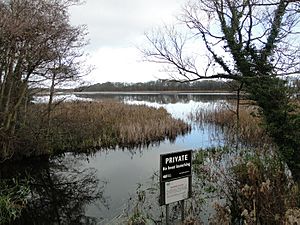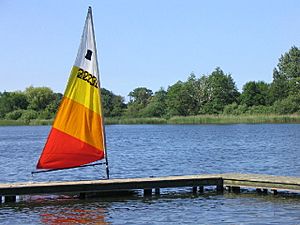Trinity Broads facts for kids
Quick facts for kids Site of Special Scientific Interest |
|

Filby Broad looking north from the bridge
|
|
| Area of Search | Norfolk |
|---|---|
| Interest | Biological |
| Area | 316.8 hectares (783 acres) |
| Notification | 1998 |
| Location map | Magic Map |
The Trinity Broads are a special natural area in Norfolk, England. They are located north of Great Yarmouth. This area is a Site of Special Scientific Interest because of its important wildlife. The Trinity Broads are also part of the Broads National Park. There are five broads here: Rollesby Broad, Ormesby Broad, Filby Broad, Lily Broad, and Ormesby Little Broad. The Broads Authority helps manage this beautiful place. The broads are connected to the River Bure, but boats cannot easily travel between them. This means the area stays very peaceful and undisturbed.
Supplying Water to Homes
In 1995, a company called Essex and Suffolk Water bought most of the Trinity Broads. They use the broads to supply drinking water to Great Yarmouth. The water here is very clean. To keep it clean, a special gate, called a sluice, was built where Muck Fleet meets the River Bure.
Essex and Suffolk Water works with other groups to protect the broads. These groups include the Broads Authority, the Environment Agency, and English Nature. Together, they make sure the broads are good for wildlife. They also allow some fun activities, but keep them at a low level. This helps protect the natural environment. Water from Muck Fleet is pumped into the River Bure by a station at Stokesby.
Cleaning Ormesby Broad
In 2010, a project started to clean up Ormesby Broad. This project cost £120,000 over three years. Workers pumped mud from the bottom of the lake. This mud had many nutrients from farm water runoff. Removing the mud helps the lake hold more drinking water. It also creates better places for reedbeds to grow along the edges.
Before pumping started, archaeologists found something amazing. They discovered an old field system from the Middle Bronze Age. This was the first time such a system was found in this area. The pumping was delayed while they studied the site. Pumping began in March 2010. It was delayed again when old ammunition was sucked up by the pumps!
By mid-May, pumping had to stop because too many water plants grew. It started again in August. By early 2011, about 20,000 cubic yards (15,000 m3) of mud had been removed. Once the mud dries, it is good for fertilizing poor soil. In the end, about twice this amount of mud will be taken from the broad.
Fun Activities at the Broads
You won't see any motor boats on the Trinity Broads. However, you can hire rowing boats and sailing dinghies. Muck Fleet, which connects the broads to the River Bure, is too shallow even for these small boats.
Besides sailing, the broads are also very popular for fishing. New facilities have been built for people with disabilities. This includes a special platform for anglers in wheelchairs.
Ormesby Little Broad is used for sailing model yachts. The Norfolk Model Yacht Club has an agreement with Essex and Suffolk Water. This allows them to use the broad once a month. Just like the bigger boats, model yachts cannot use petrol or oil engines. They are all controlled by electric motors.


